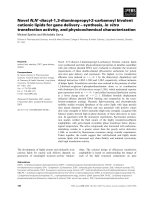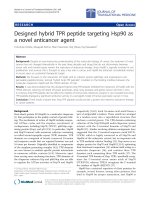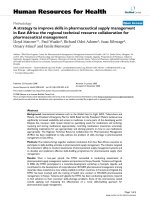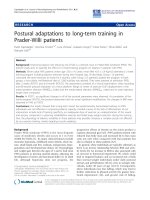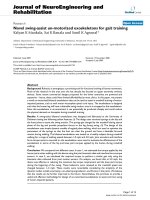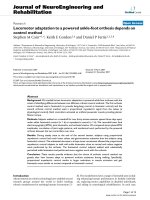Báo cáo hóa học: " Novel Strategy to Fabricate PLA/Au Nanocomposites as an Efficient Drug Carrier for Human Leukemia Cells in Vitro" pdf
Bạn đang xem bản rút gọn của tài liệu. Xem và tải ngay bản đầy đủ của tài liệu tại đây (498.99 KB, 8 trang )
NANO EXPRESS Open Access
Novel Strategy to Fabricate PLA/Au
Nanocomposites as an Efficient Drug Carrier for
Human Leukemia Cells in Vitro
Jingyuan Li
1
, Chen Chen
1
, Xuemei Wang
1*
, Zhongze Gu
1
, Baoan Chen
2
Abstract
Poly (lactic acid) (PLA) polymer has the promising applications in the biomedical field because of its biodegradability
and safe elimination. In this study, we have explored the bio-application of new nanocomposites composed with
PLA nanofibers and Au nanoparticles as the potential drug carrier for an efficient drug delivery in target cancer cells.
The results demonstrated that the anticancer drug daunorubicin could be efficiently self-assembled on the surface
of PLA/Au nanocomposites and the synergistic enhancement of PLA/Au nanocomposites conjugated with
daunorubicin into drug-sensitive K562 and drug-resistant leukemia K562/AO2 cells could be obviously observed by
MTT assay and confocal fluorescence microscopy studies. These observations suggest that the new nanocomposites
could readily induce daunorubicin to accumulate and uptake in target leukemia cells and increase the drug’s
cytotoxicity. Especially, the PLA/Au nanocomposites could significantly facilitate the cellular drug absorbtion of
daunorubicin into drug-resistant K562/AO2 cells and efficiently inhibit the cancer cell proliferation. This raised the
possibility to utilize the PLA/Au nanocomposites as a new effective additive agent to inhibit the drug resistance and
thus as a novel strategy to sensitively track the respective cancer cells.
Introduction
As one of the difficult treated diseases, cancer threats
the life of many patients. To reduce the morbidity and
mortality of cancer, early diagnosis and cance r systemic
therapies are of paramount importance. The cure effi-
ciency of cancer chemotherapy depends not only on the
anticancer drug itself but also on how the drug reagent
is efficiently delivered to its targets [1]. Although there
is much effort to solve the relevant problems, it is still a
big challenge to develop a new strategy to mark and
track the target cancer cells for the early diagnosis and
cure of cancers. Besides, the eme rgence of drug resis-
tanceisaworldwidepuzzleintherelateddiseases’
therapies, while the occurrence of the multidrug resis-
tance (MDR) phenomenon is one of the major obst acles
to the success of the tumors’ chemotherapy [2,3]. It is
noted that the mechanisms involved in drug resistance
of cancer cells are pertaining to multifactor processes.
And the cellular uptake of some drugs may be poor by
the mutated tumor cells. The proteins related with drug
resistance may pump out the drug molec ules from the
mutated tumor cells, which will decrease the drug con-
centration inside the tumor cells [4]. Thus, the efficient
targe ting of drug delivery for relevant cancer cells could
afford a new strategy for the effective treatment of tar-
geted cancers [5,6].
Recently, some reports have demonstrated that antic-
ancer drugs could be readily modified on the biocompa-
tible nanomaterials covalently or non-covalently, which
could afford the sustained drug delivery for the target
cancer cell lines and reduce the relevant toxicity toward
normal cells and tissues [7-9]. For instance, some semi-
conductor nanoparticles such as TiO
2
nanoparticles can
penetrate across barriers into cancer cells to allow effi-
cient drug accumulation at the targeted locations, which
could have promising application in biomedical and
bioengineering fields due to its oxidizing and biocompa-
tible properties, chemical inertness and photoactivity
[10-16]. Au nanoparticles were also applied as a poten-
tial carrier or protective container for biologically active
agents [8]. With the characteristics of biocompatibilit y,
biodegradability and absorbability, some polymers hav e
* Correspondence:
1
State Key Lab of Bioelectronics (Chien-Shiung WU Laboratory), Southeast
University, 210096, Nanjing, China.
Full list of author information is available at the end of the article
Li et al. Nanoscale Res Lett 2011, 6:29
/>© 2010 Li et al. This is an Open Access article distributed under the terms of the C reative Commons Attribution License
(http://creativecom mons.org/licenses/by/2.0), which permits unrestricted use, distr ibution, and reprodu ction in any medium,
provide d the original work is prope rly cited.
been widely used in medical resea rch such as DNA
binding delivery with PLA/PEG nanoparticles, poorly
soluble Ethaselen’s delivery with mPEG-PLA copoly-
mers, prostheses for tissue replacements, supporting
surgical opera tion and artificial orga ns for temporary or
permanent assistance [17-19]. Some biocomp atible poly-
mer can also act as drug carriers by controlling the
release rate of the loaded drug [20-23]. Meanwhile, the
blends of the biodegradable polymers have been
explored for the potential applications in biomedical
field such as the drug release/implants for orthopedic
surgery or blood vessels due to their good biocompat-
ibility, low cost, safe elimination, lightweight and high
performance [24-29]. Thus, on the basi s of these obser-
vations, the biodegradable poly(lactic acid) (PLA) nano-
fibers have been fabricated in this study by using
electrospinning and then adopted to blend with Au
nanoparticles to form a new nanocomposites with the
good biocompatibility. Afterward, the PLA/Au nano-
composites were further conjugated with anticancer
drug daunorubicin to efficiently facilitate the intracellu-
lar accumulation of the anticancer agents inside drug-
sensitive and drug-resistant leukemia cells.
Experimental Section
Reagents
Daunorubicin was purchased from Nanjing Pharmacy
Factory (analytical grade) and freshly prepared with
phosphate buff er solution (PBS, 0.1 M, pH 7.2). Au
nanoparticles were freshly prepared according to the
previous report [30], in which 100 mL of 0.01% HAuCl4
was heated to boiling with uninterruptedly agitating and
3.0 mL of 1% trisodium citrate was dropped into the
above solution. The system was continually agitated
about 30 min until the reaction color did not change.
Ultrapure water was added in which the final volume
was 100 mL and the diameter of Au nanoparticle was
about 15 nm. The other reagents were analytical grade.
For the following studies, all experimental measure-
ments were performed at least three times in parallel.
The Preparation of Poly(lactic acid) Nanofibers
Poly(lactic acid) nanofibers were f abricated by el ectro-
spinning. First, the poly(lactic acid) (Mn = 340,000 ) was
dissolvedinthesolventofchloroform(10%,wt)and
stirred for 2 h. Next, it was loaded into a syringe con-
nected with anodal voltage. Aluminum foil as a collect-
ing substrate was c onnected with cathodal voltage.
Electrospinning was performed at room temperature
with a gap between the substrate electrode and the tip
of the capillary of 10 cm at driving voltages of 10 kV.
The PLA nanofibers were characterized by scan ning
electron microscopy (Magnification: 10,000) as shown in
our previous report [31].
The Preparation of PLA/Au Nanocomposites Conjugated
with Dauborubicin
The aqueous suspension of PLA nanofibers was pre-
pared in double-distilled water by ultrasonic treatment
for about 20 min. Then, Au (2.80 × 10
-7
mol/L) and
PLA nanofiber gel aqueous solutions (1.3 × 10
-3
g/L)
were mixed and incubated together for more than 12 h
to form the PLA/Au nanocomposites. The solution of
daunorubicin (3.3 × 10
-4
mol/L) was mixed into the
nanocomposites and stored in the dark at 4°C for more
than12htoformthePLA/Aunanocompositesconju-
gated with dauborubicin.
Atomic Force Microscopy Study
In a relevant atomic force microscopy study (AFM),
5 μL from the aforementioned different solutions was
deposited onto freshly cleaved mica (already glued on a
steel disk) and incubated for 5 min. After the sample
dried under a nitrogen stream, imaging was performed
in tapping mode, by using a Nanoscope IIIa Multimode
AFM (Digital Instruments, Santa Barbara, CA, USA)
operating in air at room temperature.
MTT Assay
For cell culture, human leukemia cells (K562 and K562/
AO2) were cultured in a flask in an RPMI 1640 medium
(GIBCO) supplemented with 10% fetal calf serum (FCS,
Sigma), penicil lin (100 m U/mL) and streptomycin
(100 μg/mL) at 37°C in a humidified atmosphere con-
taining 5% CO
2
, while 1 μg/mL doxorubicin was con-
tained in the culture to maintain K562/AO2 cells’ drug
resistance in its daily culture.
The inhibition of cell growth was measured by MTT
(Microculture Tetrazolium) assay. Initially, the respec-
tive leukemia cells (K562 and K562/AO2) in the log
phase were seeded in a 96-well plate at a concentration
of 1.0 × 10
4
cells) well. The target cells were treated
with different concentration of PLA/Au nanocomposites,
daunorubicin or daunorubicin conjugated with PLA/Au
nanocomposites, respectively. Control s were cultivated
with the respective s olvent under the same conditions.
Each culture was incubated for 48 h in a 5% CO
2
incu-
bators at 37°C, and then 20 μLof5mg/mLMTTwas
added to the wells and incubated for an additional 4 h.
Subsequently,itwascentrifugedat1,000rpmfor
10 min and the supernatant w as discarded, follo wed by
the addition of 150 μL of dimethyl sulfoxide (DMSO)
into each well and then incubat ed in the shaker at 37°C
with gentle shaking ab out 5 min. Then, the optical den-
sity (OD) was read at a wavelength of 492 nm.
Laser Confocal Fluorescence Microscopy
The cel l cul ture conditions were simil ar to those
described above. Initially, the different cells were
Li et al. Nanoscale Res Lett 2011, 6:29
/>Page 2 of 8
collected by centrifugation at 1,000 g for 5 min. T hen,
the supernatant solutions were discarded. The pellets
were resuspended with PBS to eliminate the effect of
medium in the fluorescence detection. And the cell sus-
pension was detected on a Leica TCS SP2 (Leica).
In the control experiments, only daunorubicin or PLA/
Au nanocomposites were injected for relevant cellular
incubation. The freshly prepared cell culture was
dropped on a strictly cleaned glass plate immediately
before the measurement. The excitation wavelength of
fluorescence was 480 nm. All the optical meas urements
were carried out at room temperature (20 ± 2°C).
Results and Discussion
AFM Study of PLA/Au Nanocomposites Conjugated with
Daunorubicin
As shown in Figures 1 and 2, the AFM images of PLA
nanofibers, Au nanoparticles and the blending of the
PLA/Au nanocomposites with daunorubicin demon-
strate that upon blending of daunorubicin with the
PLA/Au nanocomposites, some relatively large nano-
spheres appear at PLA chains. It is observed that there
was a discernible substrate under the spherical particles,
which is at the same level as the pure PLA nanofiber,
the average height of which is about 1.5 ± 0.05 nm.
Meanwhile, relevant measurements show that the aver-
age height of the conjugat ed nanocomplexes was ( 26 ±
0.62) nm, and the average outer diameter of spherical
nanoparticles was (22 ± 0.55) nm. It is apparent that the
Au nanoparticles and the drug molecules could self-
assemble or pack together to form the spherical particles
on poly(lactic acid) nanofibers, as shown in Figure 2.
The rational behind this could be attributed to the fact
that daunorubicin is positively charged while the relative
surface of nano PLA/Au polymer nanofibers is nega-
tively charged in pH 7.2 PBS solution. Thus,
daunorubicin could be readi ly self-assembled o nto the
surface of PLA/Au nanocomposites through electrostatic
interaction and other non-covalent binding.
Since the PLA nanofiber has a very high continuous
surface area, it has attracted a great deal of attention i n
fabricating continuous ultrafine fibers or fibrous struc-
tures for various polymers, with typical examples includ-
ing e ngineering p lastics, biopo lymers and polymer
blends [32,33]. From the specific nanostructu re of the
PLA nanofibers and the relevant nanocomposites
observed in above AFM study, it is evident that the
anticancer drug daunorubicin could be r eadily self-
assemb led on the surface of the new PLA/Au nanocom-
posites, which could be utilized as a new promising
carrier for nanomedicine in cancer treatment.
Fluorescence Imaging of Intracellular Drug Delivery in
Leukemia Cancer Cells
Based on the above observations, the PLA/Au nanocom-
posites have been further explored as a new potent ial
drug carrier for efficient drug delivery. Initially, the
microscopy images of leukemia cancer cells in the
absence and presence of PLA/Au nan ocomposites have
been investigated by optical microscopy. As shown in
Figure 3, it is observed that the drug-sensitive leukemia
cancer cells K562 and drug-resistant leukemia cancer
cells K562/AO2 ha d the good morphology in the nega-
tive control. While K562 cells were cultured with DNR
conjugated with PLA/Au nanocomposites, significant
morphological changes were detected and more cell
death occurred than that of cells treated with DNR
alone. In comparison, there were no any morphological
changes for drug-resistant leukemia cells K562/AO2
after treated with DNR alone because of the relevant
multidrug resistance, as shown in Figure 3b and 3d.
After the cells were treated by DNR conjugated with
Figure 1 Typical AFM images of a Au nanoparticles, and b PLA nanofiber.
Li et al. Nanoscale Res Lett 2011, 6:29
/>Page 3 of 8
Figure 2 Typical AFM images of nano PLA/Au polymer nanofibers (a) and PLA/Au nanocomposites conju gated with daunorubici n
(3.30 × 10
-4
M) (b). Z Scale: 200 nm.
Figure 3 Optical microscopy images of leukemia cancer cells. a K562 cells, c K562 treated with DNR, e K562 treated with DNR conjugated
with PLA/Au nanocomposites (DNR was 1 × 10
-6
M in the above systems); b K562/AO2 cells, d K562/AO2 treated with DNR, f K562/AO2 treated
with DNR conjugated with PLA/Au nanocomposites (DNR was 1 × 10
-6
M in the above systems).
Li et al. Nanoscale Res Lett 2011, 6:29
/>Page 4 of 8
Figure 4 Confocal fluo rescence microscopy images of different leukemia cancer ce lls treated with a nticancer agents. a K562 treated
with DNR, c K562 treated with DNR and PLA nanopolymers, e K562 treated with DNR conjugated with PLA/Au nanocomposites (DNR was 1 ×
10
-6
M in the above systems); b K562/AO2 treated with DNR, d K562/AO2 treated with DNR and PLA nanopolymers, f K562/AO2 treated with
DNR conjugated with PLA/Au nanocomposites (DNR was 1 × 10
-6
M in the above systems). g and h, respectively, give the quantitative
fluorescence intensity curves of images for K562 system (g) and K562/AO2 system (h) in which the single cell was respectively selected from the
above related systems.
Li et al. Nanoscale Res Lett 2011, 6:29
/>Page 5 of 8
PLA/Au nanocomposites, significant increase in the cell
death could be detected. Considering the good biocom-
patibility of PLA and Au nanomaterials, these observa-
tions suggest that the apparent increase in cancer cell
death should be attributed to the synergis tic function
derived from the combination of DNR with PLA/Au
nanocomposites. Especially, the PLA/Au nanocompo-
sites–DN R c omplexes can remarkab ly facilitate
the accumulation of the DNR molecules in the drug-
resistant cancer cells and apparently reserve the MDR of
K562/AO2.
With the good fluorescence characteristics, DNR
could also be utilized as the fluorescence probe to
track its location and concentration inside the cells. As
shown in Figure 4, the synergistic effect for the uptake
of DNR on K562 and K562/AO2 could be obviously
observed by the laser confocal fluorescence micro-
scopy. Figure 4 showed the typical images of the con-
focal fluorescence microscopy of different leukemia
cancer cells. It appeared that the relative ly weak drug
uptake was observed w hen the cancer cells were only
treated with DNR. While the intracellular fluorescence
was slightly strengthened after relevant cells incubated
by DNR together with PLA nanofibers. In comparison,
when PLA/Au nanocomposites conjugated with DNR
were incorporated into the target system, PLA/Au
nanocomposites have an apparent synergistic effect on
the drug uptake of DNR in the respective cancer cells,
where the intracellular fluorescence intensity was
remarkably enhanced upon application of the PLA/Au
nanocomposites together with DNR, as shown in
Figure 4e and 4f. Since the PLA/Au nanocomposites
themselves have no fluorescence, the intracellular
fluorescence was only generated by the anticancer drug
DNR. Our previous study indicates that the presence
of bare Au nanoparticles alone could just slightly
enhance the uptake of DNR by K562 cells [8]. Hence,
these results indicated that much more DNR molecules
could be efficiently accumulated i n the cancer cells
upon application of DNR together with PLA/Au
nanocomposites.
Additionally, our observations demonstrate that for
drug-resistant K52/AO2 cells treated with DNR alone,
scarce cancer cells with weak intracellular fluorescence
could be observed. The very weak intracellul ar fluores-
cence of drug-resistant leukemia cells treated with
DNRalonemaybeattributedtotheover-expressionof
P-gp protein on the cell memb rane of the drug-resis-
tant cancer cells [34,35], which could readily pump
DNR molecules out of the relevant cancer cells so that
much lower intracellular DNR fluorescence could
be observed for K562/AO2 cells than that of
K562 cells, as shown in Figure 4a and 4b. Interestingly,
the presence of PLA/Au nanocomposites could effi-
ciently facilitate the drug uptake of DNR into the
drug-resistant leukemia cells and lead to the much
higher intracellular drug concentration in the target
cells, resulting in the remarkable enhancement of the
intracellular fluorescence of drug-resistant leukemia
cells (Shown in Figure 4b and 4f). This result suggests
that the PLA/Au nanocomposites may affect the activ-
ity of P-gp protein and effi ciently prevent the drug
efflux from the d rug-resistant leukemia cells. Thus,
much more DNR could be readily permeated and
accumulated into the relative cancer cells because the
relevant synergistic effect of the PLA/Au nanocompo-
sites could apparently inhibit the drug resistance of
K562/AO2. In view of these observations, it appears
that the PLA/Au nanocomposites may play as potential
inhibitor of multidrug resistance (MRD) and thus effi-
ciently promote the cellular uptake of the drug into
the relevant drug-resistant cancer cells.
Cytotoxicity Study by MTT Assay
The cell viability of leukemia cancer cells in the pre-
sence of PLA/Au nanocomposites loaded with DNR has
been explored by MTT assay. As shown in Figure 5, the
results demonstrate that the com bination of the PLA/
Au nanocomposites with DNR could more effectively
inhibit the growth of these two different kinds of le uke-
mia cells than that treated with DNR alone. It is evident
that the biocompatible PLA/Au nanocomposites have a
synergistic effect to facilitate the drug uptake into
human leukemia cells, increase the relative intracellular
drug concentration and hence enhance the cytotoxicity
of anticancer agents. Meanwhile, it is observed that the
inhibition effect for drug-resistant K562/AO2 cancer
cells was relatively significant than that for drug-
sensitive K562 cancer cells when treated with DNR con-
jugated with PLA/Au nanocomposites. As shown in
Table 1, our results revealed that the resistant factor of
the reversal index to resistant leukemia cells was 70.14
for K562/A02 in the control group, while the resistant
factorinthepresenceofthe PLA/Au nanocomposites
significantly decreased to 38.88; therefore, the reversal
index to K562/A02 was 1.8. This suggests that the pre-
sence of PLA/Au na nocomposites can reinforce th e
accumulation of DNR in drug-resistant K562/A02 cells
and lead to a great extent decreasing of the resisting fac-
tors. Thus, the interaction of PLA/Au nanocomposites
with bioactive molecules on the cell membrane could
provide a new strategy to overcome the mu ltidrug resis-
tance (MDR) of K562/AO2 cells by improving the effi-
ciency of drug delivery. These observations were
coherent with the above results of confocal fluorescen ce
studies.
Li et al. Nanoscale Res Lett 2011, 6:29
/>Page 6 of 8
Conclusion
In summary, in this study we have fabricated the new
PLA/Au n anocomposites and explored the promising
application of the PLA/Au nanocomposites to efficiently
facilitate the uptake of anticancer drug in target cancer
cells. Our observations demonstrate that the self-assem-
bly and conjugation of anticancer drug DNR on the sur-
face of PLA/Au nanocomposites could significantly
enhance the drug accumulation into drug-sensitive K562
and drug-resistant leukemia K 562/AO2 cells and thus
increase the drug’s cytotoxicity. Importantly, the PLA/Au
nanocomposites could considerably reverse the multi-
drug resistance of K562/AO2 cells and efficiently inhibit
the cancer cell proliferation. This raised the possibility to
utilize the PLA/Au nanocomposites as a n ew eff ective
additive agent to overcome the drug resistance a nd thus
as a novel strategy to sensitively track the respective can-
cer cells for efficient cancer chemotherapy.
Acknowledgements
This work is supported by National Natural Science Foundation of China
(90713023, 20675014 and 20535010), National Basic Research Program of
China (No. 2010CB732404), the Chinese Ministry of Science and Technology
(2007AA022007 and 2008DFA51180), the Natural Science Foundation of
Jiangsu Province (BK2008149), Visiting Scholar Foundation of Key Laboratory
of Biorheological Science and Technology (Chongqing University) and the
Graduate Research and Innovation Program of Jiangsu Province
(CX10B_083Z).
Author details
1
State Key Lab of Bioelectronics (Chien-Shiung WU Laboratory), Southeast
University, 210096, Nanjing, China.
2
Department of Hematology, Zhongda
Hospital, Southeast University, 210096, Nanjing, China.
Received: 3 July 2010 Accepted: 14 August 2010
Published: 14 September 2010
References
1. Alexiou C, Arnold W, Klein RJ, Parak FG, Hulin P, Bergemann C, Erhardt W,
Wagenpfeil S, Lubbe AS: Cancer Res 2000, 60:6641-6648.
2. Breuninger LM, Paul S, Gaughan K, Miki T, Chan A, Aaronson SA, Kruh GD:
Cancer Res 1995, 55:5342-5347.
3. Litman T, Nielsen D, Skovsgaard T, Zeuthen T, Stein WD: Biochim Biophys
Acta 1997, 1361:147-158.
4. Song M, Guo DD, Pan C, Jiang H, Chen C, Zhang RY, Gu ZZ, Wang XM:
Nanotechnology 2008, 19:165102.
5. Zhang RY, Wang XM, Wu CH, Song M, Li JY, Lv G, Zhou J, Chen C, Dai YY,
Gao F, Fu DG, Li XM, Guan ZQ, Chen BA: Nanotechnology 2006,
17:3622-3626.
6. Wu W, Wieckowski S, Pastorin G, Benincasa M, Klumpp C, Briand JP,
Gennaro R, Prato M, Bianco A: Angew Chem Int Edit 2005, 44(39):6358-6362.
7. Peng T, Su J, Cheng SX, Zhuo RX: J Mater Sci Mater M 2007,
18(9):1765-1769.
8. Li JY, Wang XM, Wang CX, Chen BA, Dai YY, Zhang RY, Song M, Lv G,
Fu DG: Chem Med Chem 2007, 2(3):374-378.
9. Bianco A, Kostarelos K, Partidos CD, Prato M: Chem Commun 2005,
2:571-577.
10. Schroeder U, Sommerfeld P, Ulrich S, Sabel BA: J Pharm Sci 1998,
87(11):1305-1307.
11. Paciotti GF, Kingston DG, Tamarkin L: Drug Develop Res 2006, 67:47-54.
12. Li JY, Wu CH, Gao F, Zhang RY, Lv G, Fu DG, Chen BA, Wang XM: Bioorg
Med Chem Lett 2006, 16(18):4808-4812.
13. Nie X, Leyland A, Matthews A: Surf Coat Tech 2000, 125:407-414.
14. Ishihara T, Mizushima T: Expert Opin Drug Del 2010, 7(5):565-575.
Table 1 The resistant factors and reversal index of leukemia K562 and K562/AO2 cell lines to PLA/Au nanocomposites
Groups IC50/μmol/L Resistant factors Reversal index
K562 K562/AO2
Control group 0.51 35.77 70.14 1.8
Experimental (PLA/Au) group 0.25 9.72 38.88
0
20
40
60
80
Decrease of cell viability/ %
Concentration of DNR/ μmol/L
-(DNR)
-(PLA+DNR)
-(PLA/Au+DNR)
0.1
0.2
0.4
0.6 0.8
0
20
40
60
80
Decrease of cell viability/ %
Concentration of DNR/ μmol/L
-(DNR)
-(PLA+DNR)
-(PLA/Au+DNR)
2.5
510
20
40
AB
Figure 5 MTT assay to test the cytotoxicity of DNR in the presence of PLA or PLA/Au nanocomposites for K562 cells (a) and K562/
AO2 cells (b) for 48 h. Error bars, ±SEM.
Li et al. Nanoscale Res Lett 2011, 6:29
/>Page 7 of 8
15. Chen C, Lv G, Pan C, Song M, Wu CH, Guo DD, Wang XM, Chen BA, Gu ZZ:
Biomed Mate 2007, 2:L1-L4.
16. Wang L, Neoh KG, Kang ET, Shuter B, Wang SC: Biomaterials 2010,
31(13):3502-3511.
17. Zou WW, Liu CX, Chen ZJ, Zhang N: Nanoscale Res Lett 2009, 4(9):982-992.
18. Li XR, Yang ZL, Yang KW, Zhou YX, Chen XW, Zhang YH, Wang F, Liu Y,
Ren LJ: Nanoscale Res Lett 2009, 4(12):1502-1511.
19. Jagur-Grodzinski J: Polym Advan Technol 2006, 17(6):395-418.
20. Ha CS, Gardella JA: Chem Rev 2005, 105:4205-4232.
21. François F, Quinn DJ, Gilmore BF, McCarron PA, Scott cJ: Biomaterials 2010,
31(14):4214-4222.
22. Feng ZQ, Chu XH, Huang NP, Leach MK, Wang G, Wang YC, Ding YT,
Gu ZZ: Biomaterials 2010, 31(13):3604-3612.
23. Hou ZQ, Wei H, Wang Q, Sun Q, Zhou CX, Zhan CM, Tang XX, Zhang QQ:
Nanoscale Res Lett 2009, 4(7):732-737.
24. Eberhart RC, Su SH, Nguyen KT, Zilberman M, Tang L, Nelson KD, Frenkel P:
J Biomat Sci Polym E 2003, 14:299-312.
25. Liao SS, Cui FZ, Zhang W, Feng QL: J Biomed Mater Res B 2004,
69(2):158-165.
26. Aou K, Kang S, Hsu SL: Macromolecules 2005, 38(18):7730-7735.
27. Huda MS, Drzal LT, Misra M, Mohanty AK, Williams K, Mielewski DF: Ind Eng
Chem Res 2005, 44(15):5593-5601.
28. Jee KS, Park HD, Park KD, Kim YH, Shin JW: Biomacromolecules 2004,
5:1877-1881.
29. Carlson D, Nie L, Narayan R, Dubois P: J Appl Polym Sci 1999, 72(4):477-485.
30. Zhang RY, Wang XM, He NY: J Nanosci Nanotech 2005, 5:1245-1248.
31. Lv G, He F, Wang XM, Gao F, Zhang G, Wang T, Jiang H, Wu CH, Guo DD,
Li XM, Chen BA, Gu ZZ: Langmuir 2008, 24:2151-2156.
32. Teo WE, Ramakrishna SA: Nanotechnology 2006, 17:89-106.
33. Li D, Wang YL, Xia YN: Nano Lett 2003, 3(8):1167-1171.
34. Roninson IB: Clin Physiol Biochem
1987, 5(3–4):140-151.
35. Hu Z, Jin SK, Scotto KW: J Biol Chem 2000, 275:2979-2985.
doi:10.1007/s11671-010-9762-3
Cite this article as: Li et al.: Novel Strategy to Fabricate PLA/Au
Nanocomposites as an Efficient Drug Carrier for Human Leukemia Cells
in Vitro. Nanoscale Res Lett 2011 6:29.
Submit your manuscript to a
journal and benefi t from:
7 Convenient online submission
7 Rigorous peer review
7 Immediate publication on acceptance
7 Open access: articles freely available online
7 High visibility within the fi eld
7 Retaining the copyright to your article
Submit your next manuscript at 7 springeropen.com
Li et al. Nanoscale Res Lett 2011, 6:29
/>Page 8 of 8

